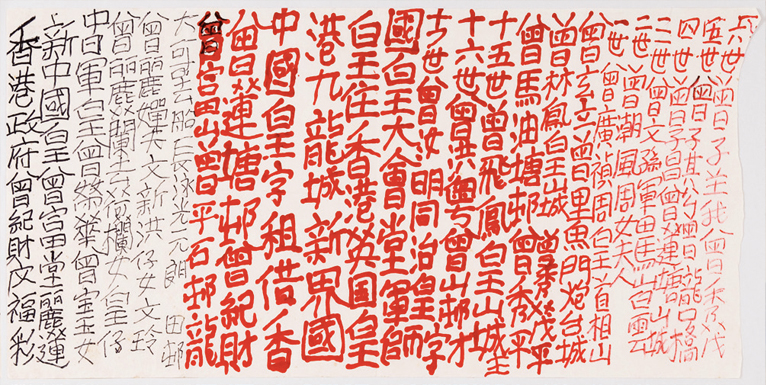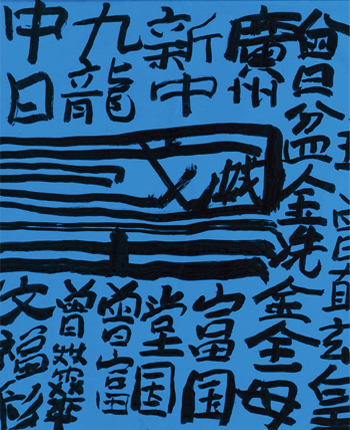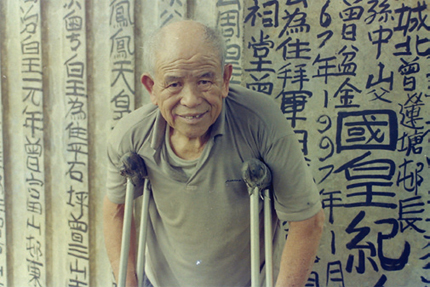THE GRAFFITI DIARIES OF THE KING OF KOWLOON
| June 3, 2012 | Post In LEAP 14

Honest, upright, at ease, strolling everywhere as he pleased,
In the urban noise, applying brush to walls, electrical boxes, and lampposts,
He surpassed them all, writing the epic of Kowloon.
Sweat and ink, a jumble of fonts large and small,
With steady smile from start to finish,
He loved nothing more than an ice-cold coke.
White paper; wooden boards, crappy concrete, old shirts, bath towels, restaurant signs:
His talents displayed on everything,
On land parceled up and seized under Bow-Tie Tsang and Tung Chee Hwa;
On the territory that would always remain unchanged.
Fuk-choi eternally by his side,
In writing, his queen to the end.
He didn’t miss a thing… his aspirations vast and broad,
Unmoved by the crown.
He fully devoted himself to memory:
Every trace, every trifle, of every month, of every year;
And that’s enough.
– IN HIS SONG The Graffiti Diaries, Chet Lam sings about a man who inhabits the collective memory of a generation of Hong Kong residents, the legendary Tsang Tsou Choi.
Up to the present moment, in all locations across the globe, the production of graffiti is still largely considered an illegal act. While street advertisements and scrawled expressions of personal hate and praise cannot be categorized as art, there remains those examples of graffiti that bear the characteristics of objective thought and topical commentary, and thereby warrant consideration of their artistic merit. To the clandestine creators of these works, the city is a canvas, an amusement park, and, most of all, it is the outward limit of their realm of emotional expression. That the power and action of a single individual can transform the appearance of a city is an exciting prospect, and one that differs greatly from acts of personal artistic cultivation performed by painting or writing within one’s familiar environs. Creation in public spaces is an act of apparently greater emotional intensity, and one necessarily rife with unknowns.

Tsang Tsou Choi— or the King of Kowloon, as he would prefer to be remembered— was one of the premier graffiti artists of Hong Kong, his career spanning 50 years until his death from a sudden heart attack at Hong Kong United Hospital on July 15, 2007. There remain in the streets and alleyways of Hong Kong numerous examples of his “calligraphic graffiti.” In contrast to undercover graffiti artists who ply their trade under the cloak of night, Tsang Tsou Choi worked a brave daylight beat for decades, undeterred by wind and rain, leaving behind works ranging from small-scale mailboxes and electrical boxes to entire walls of railway and subway stations. Having persisted in working outside the law despite repeated fines and punishments, then supported by Hong Kong welfare services in his later years, his life story reads like a fairy tale of the graffiti world.
Tsang Tsou Choi— born Tsang Choi on November 12, 1921 in Liantang Village, Guangdong, China— only received two years of formal education. At 16 he moved to Hong Kong to live with an uncle, later receiving citizenship. He worked as a laborer at construction sites and garbage collection facilities until 1980, when his legs were crushed in a work accident. Thereafter, he walked only with the assistance of crutches. While visiting his hometown at age 35, he discovered records indicating an illustrious family history. His ancestor Zeng Guangzhen had been a senior official at the court of the Zhou dynasty, and possessed extensive land titles in Sau Mau Ping, in eastern Kowloon. Zeng Chaofeng, one generation removed from Zeng Guangzhen, was son-in-law to the Zhou emperor, and had lived for a time in Kowloon. Thus, Tsang Tsou Choi began to view himself as the thirty-fifth generation claimant to the Sau Mau Ping estates, and further extrapolated that the whole of Hong Kong would be the rightful inheritance of the Tsang family had legal matters not been complicated by the humiliating Treaty of Nanjing, which had ceded the territory to England. When faced with loss of land and rights, common people often have no choice but to align themselves to the motion of the great wheels of history, and capitulate to the powers that be. Yet in the midst of the 1960s, when the grip of the British colonial government was exerting maximal force, Tsang Tsou Choi turned to graffiti as a means of peaceful protest, retelling the distinguished history of his ancestors, denouncing the incursions of the British government, and even cursing the name of the queen. The anti-colonialist sentiments embodied by this innovative approach to asserting his rights were a direct mockery of Hong Kong government claims to power, making use of public spaces to progressively delineate the territory of his personal empire. The particular nature of Tsang Tsou Choi’s art makes his works inseparable from their background context. On a certain level, separating his graffiti from the situational context to which it refers would negate its inherent meaning.
The graffiti of Tsang Tsou Choi was executed using brush and ink, which helps differentiate his work from the forceful style of Western graffiti art, and brings out associations with the literati culture of the East. Judged by their form, Tsang Tsou Choi’s characters appear clumsy and naïve. They vary in size, and fail to accord with standard stroke orders and accepted rules of spacing and proportion. Often they are written right to left, top to bottom, in the style of classical Chinese texts, though the classical preference for uniform line lengths is often broken by trailing characters that cross out of the boundaries of the painting surface. Although his writings are spontaneous, appearing to spring forth from the brush without any plan, they always maintain a satisfying visual harmony. His bold and easy brushwork repeatedly bunches together to form the stacks of text that are the defining structural element of his work.

As a solitary artist, Tsang Tsou Choi was fortunate to encounter admirers and advocates of his work during his lifetime. In April 1997, Hong Kong art critic Lau Kin-wai organized solo exhibitions of Tsang Tsou Choi’s calligraphy at the Hong Kong Arts Centre and the Goethe-Institut, bringing Tsang’s art off of the streets and into galleries for the first time. The controversy surrounding these exhibitions accelerated the growing awareness and examination of Tsang Tsou Choi’s work both in Hong Kong and worldwide. In 2001, Swipe cleaning products invited Tsang to act as their spokesperson, and appear in television ads demonstrating his work. By this time the King of Kowloon was already a household name in Hong Kong. In 2003, Hou Hanru, curator of the 2003 Venice Biennale, incorporated Tsang’s work into the exhibition “Canton Express,” which marked the first time a Hong Kong artist had ever shown work at the Biennale. Tsang’s calligraphy has become a visual icon of the city of Hong Kong, and has been repeatedly appropriated and explored in the work of other artists and designers across the globe, to the point that his calligraphic style has now been incorporated into mainstream fashion. In January of this year, the “King of Kowloon” exhibition at Saamlung in Hong Kong displayed a collection of Tsang’s forgotten works. As opposed to past documentarian attempts to situate Tsang Tsou Choi’s work against the backdrop of Hong Kong and Hong Kong society, the exhibition cut away all vestiges of the urban landscape, allowing his calligraphy to be reexamined as objects unto themselves.
The fact that Tsang Tsou Choi persevered for decades as a graffiti artist under the constant pressure of public opinion and legal restriction speaks to his powerful and deep-seated drive to create. Graffiti is a mode of behavior that inherently involves intentional transgression and thrill seeking. At a certain level, it can be said to arise from the attitude of the “kidult”— an adult who retains the heart of a child. Thus, Tsang Tsou Choi’s calligraphic graffiti can be viewed as arising out of a love for play that, over the course of decades, became entrenched as habit. His spontaneous acts of writing carry traces of anarchist thought. He intentionally refused to live according to accepted norms, disregarded his clothing and appearance to the point of appearing slovenly and unkempt, yet lived a full and satisfying life. His image in the memory of the people of Hong Kong is that of a smiling shirtless man on crutches, much like the contented and highly venerated Maitreya Boddhisattva, or a mendicant monk wandering this mortal realm, his every action proclaiming, “Long live the King of Kowloon!”
In the years since his passing, the glorious empire of the King of Kowloon has waned, or perhaps it simply succumbed to Hong Kong’s efforts to scrub the city clean. After the last drop of the King’s ink is wiped away, this city will have transformed itself into another Singapore, impervious to all marks and stains. The urban wanderers who once walked the streets of Hong Kong, lodged in its humble rooms, and paced its bus and subway stations will have disappeared without a trace. Tsang Tsou Choi’s art is already a part of the collective memory of a certain generation of Hong Kong residents, where its creator’s existence limns an image symbolic of freedom and equal rights. The court of the king will vanish, its written records will be scrubbed away with Swipe, and the memories will become distant with the passing of time. But the legend of the King of Kowloon will always remain unprecedented and irreplaceable, never to be written again. (Translated by Joshua Dyer)

